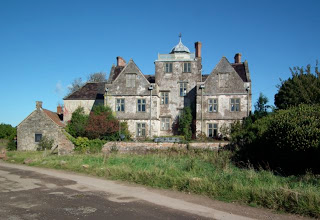Sunday, October 14, 2012
Lydney, Gloucestershire
A glimpse of gables
After a short walk around the restored docks at Lydney when I watched mist lift from the River Severn, I walked back towards the industrial estate under a virtually cloudless sky. Glancing up a potholed road past silent factories (whitewashed brick, shuttered concrete, blanked-out windows, lots of chain-link fencing and barbed wire) I caught sight of an old gable. I followed the chain-link fence until I left it behind and, beyond a field, a view opened up of a gabled sandstone house of the 17th century.
This is Naas House, built for the Jones family (William Jones was founder of the Haberdashers' Company in London) probably in the early-17th century. It's a big house – this is just one end – and the mullioned windows, string courses, and parapeted gables are very much of the period, as are the false windows in the gables. The central turret, though, with its lead-covered cupola, is a sophisticated touch. From here the owners could walk out on to a viewing platform and look towards the River Severn (to the right) or towards Lydney and the Forest of Dean (to the left).
The Jones family upgraded the interior in the early 18th century, installing panelling in a number of rooms, but in 1771 Mary Jones, daughter of the owners, was murdered on her way home from a dinner at the rectory at Lydney. Soon after this the family moved to another house near Newnham on Severn. Although the family kept Naas House (a Rev Edward Jones lived there in 1839) it was no longer their main residence and this was probably why there were few further alterations and the house keeps its Jacobean character in its quiet backwater.
Subscribe to:
Post Comments (Atom)




4 comments:
I've only recently discovered your blog, but I'm already fairly addicted.....so, thank you.
your reticence concerning themurder of Miss Jones led me a'googling. I was particularly delighted to come across this comment on the internet: "The forest history e-book newly posted on this site reveals, on page 209, that the murderer of Mary Jones of Naas House was a young labourer named Morgan. In the course of the murder, Mary was robbed of her jewels. When the crime was discovered, everyone turned out on a hue and cry except for one man, Morgan. He, by contrast, was found at home in bed, with bloodstains about him and the jewels in the thatch. Unsurprisingly, he was convicted and executed. Perhaps 'tis Morgan's ghost still stalking the neighbourhood, unable to rest for his folly of failing to dispose of the evidence. Or perhaps 'tis Mary Jones, for her folly of flaunting the bling."
Don't you just love that phrase "her folly of flaunting the bling"?
thanks again for your genuinely invigorating blog,
david Terry
www.davidterryart.com
David: Thank you so much for your appreciation – and for the priceless quotation.
in the 1940 an 50s we when i lived in lydney it was a big farm my gran lived in nass court we ues to play cricket on sundays in the field on the left of the farm Charlie Biddles ran the farm ...
This is fascinating as my great grandfather x 3 had a brother, Thomas Apperley, who married Elizabeth Jones, granddaughter of Willoam Jones and Cholmondeley D'Oyly.
Post a Comment